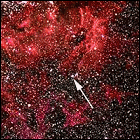 Astronomers both amateur and professional glimpse the first supernova to occur in the age of modern science. Given the name Supernova 1987A, the huge burst of light – visible to the naked eye in Earth’s southern hemisphere by the early summer months of 1987 before it begins fading out – is a collapsing star on the edge of the Tarantula Nebula. The star previously seen in that location is a blue supergiant, which wasn’t a likely candidate to go nova according to the existing theories of stellar evolution at the time. In the 1990s, the slowly expanding ring of debris rushing outward from Supernova 1987A becomes a favorite observation target for the Hubble Space Telescope. The supernova is more than 150,000 light years away from Earth’s solar system in the direction of the Large Magellenic Cloud.
Astronomers both amateur and professional glimpse the first supernova to occur in the age of modern science. Given the name Supernova 1987A, the huge burst of light – visible to the naked eye in Earth’s southern hemisphere by the early summer months of 1987 before it begins fading out – is a collapsing star on the edge of the Tarantula Nebula. The star previously seen in that location is a blue supergiant, which wasn’t a likely candidate to go nova according to the existing theories of stellar evolution at the time. In the 1990s, the slowly expanding ring of debris rushing outward from Supernova 1987A becomes a favorite observation target for the Hubble Space Telescope. The supernova is more than 150,000 light years away from Earth’s solar system in the direction of the Large Magellenic Cloud.
